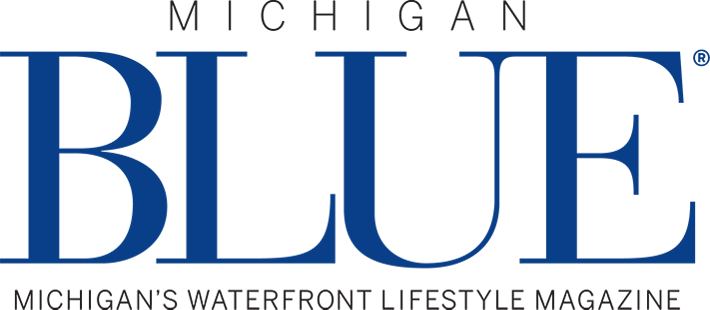Artist Laura Whitesides Host has Lake Michigan running through her veins, and she says that particular Great Lake will forever be a source for her paintings. In fact, sunsets, beach strolls, and collecting shoreline keepsakes were (and still are!) as much a part of this Grand Haven native’s being as sand is to the lake’s makeup.
In 2001, Host and her husband purchased a cottage just around the corner from her parents’ home. The cedar-frame house tucked in the woods, down the street from the beach, is the perfect getaway for the couple. “Seeing the horizon — that lake and that sky — seems to center everything,” Host says. “It calms me down. That line is always there. I always feel I have the best of the neighborhood, as we’re just a short walk to the water and yet nestled in the woods.”
In a recent conversation, she spoke about everything from the gelatin plates she uses for her art to her night-owl habits.
BLUE: Water is an important element in your life. Can you expand on how it affects your art?
Laura Whitesides Host: Water’s been important to me my whole life. I think I swam before I walked. I was at the beach all the time. I learned to sail when I was a Girl Scout in Grand Haven. I actually taught my dad how to sail, and he bought a sailboat. I’m intrigued with water patterns, and that shows up in my art.

BLUE: Water certainly inspired “The Wave,” a piece of artwork that you created, right?
LH: Yes! I used some rice paper that has swirls in it, so it created like a wave feel. I inked the paper and had fun with it.
BLUE: You talk about the horizon a lot. Does it appear often in your works?
LH: Oh, yes. It’s there often, and often subconsciously. It settles me. I like to divide spaces up. When I was in college (in the University of Michigan’s Architecture and Design College), I’d often draw something like a TV outline on my canvas before beginning to draw, so (I had) something to enter into.
BLUE: What medium do you work in?
LH: Watercolor, fluid acrylics, and I use gelatin plates for my monotypes. I usually use an etching press to make the prints that feature printing inks, but I also use watercolor.
BLUE: You use gelatin plates for your print-making pieces. Tell us about them.
LH: I make my own. An artist friend gave me several gallons of gelatin (he was also in the food business) years ago, and that’s what I still use today. You add water to the gelatin, cook it, throw it into a pan, and cure it. Then you put paint on it and put the paper on top. So there’s no rolling, just print-making.
BLUE: We understand you also teach. What and where do you teach?
LH: I teach at the Birmingham Bloomfield Art Center (BBAC) in Birmingham. It’s going on 30 years! I teach three classes: Unique Techniques, Painterly Printmaking, and Wet and Wild. I use lots of different techniques, etching presses, you name it. Most of it is experimental.

BLUE: An art center can become a home for many artists. Do you find that to be true in your relationship with the BBAC?
LH: Oh, yes, I love that place. I started taking classes there in 1980. It was a Thursday night watercolor class. Then, when my kids started to go to school, I’d take classes during the day, hoping they wouldn’t get sick! Today, I’m a teacher. I love teaching there because students are taking classes because they want to be there. People are excited about making neat things.
BLUE: Many of your pieces are multidimensional or multimedia, with many layers. Do you have an end in mind when you start on these intricate works?
LH: I see something somewhere — like on Pinterest, for example — that catches my fancy. I’ll think about it a bit. In printmaking, I might cut paper into strips or into different shapes and then ink them and put them down and play with them, and add to it. I do something, and then I react. I’m influenced by each mark as it happens.
BLUE: What shapes and colors do you like?
LH: I like contrasting geometric lines and shapes. Everything seems to have turquoise in it, but I’ve been trying to do different color schemes.

BLUE: Tell us about your affiliate with the Lawrence Street Gallery in Ferndale.
LH: It’s an artist-run gallery that shows wonderful art and has fascinating exhibits. I was one of their first members in 1987, and now I’m the president.
BLUE: When do you create a lot of your art?
LH: I’m definitely more alert at night. In fact, I started teaching at night. I guess you could say I’m a night owl! I think my parents were night owls, so that might have been instilled in me from the get-go! The morning is my planning time, and then I start to really create in the afternoon and later.

BLUE: You paint watercolor paintings, as well as monotypes and monoprints. What’s the difference between the latter two?
LH: A monoprint is done on a Plexiglas plate, using a printing ink or watercolor. The paper is damp, so it reactivates the ink/watercolors. The gelatin plate allows one to use acrylics. The difference between monotypes and monoprints is that the monotype starts with a blank plate. The monoprint plate has something in it that will appear in every print, such as lines scratched in the plate or textures glued to a plate. Each print is inked differently, but the extra element will be present in all of them. So they’re one-of-a-kind, but there’s a common element. That’s why it’s so much fun to see how many versions you can create with those common elements. The monotype and monoprint are both hand-pulled prints.
More information: laurawhitesideshost.com, lawrencestreetgallery.com









Facebook Comments